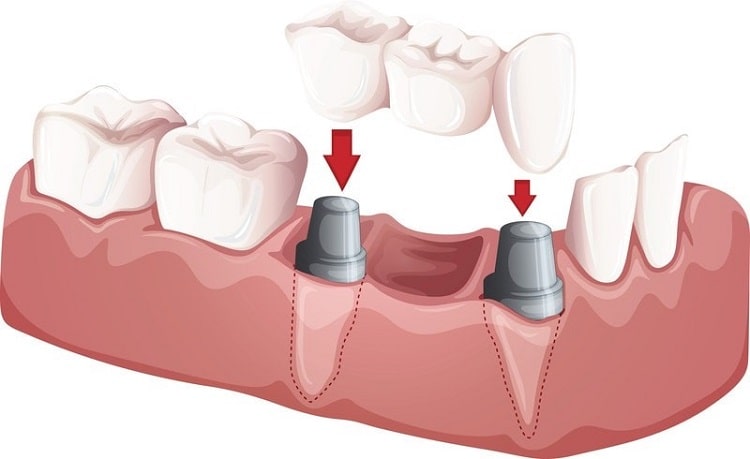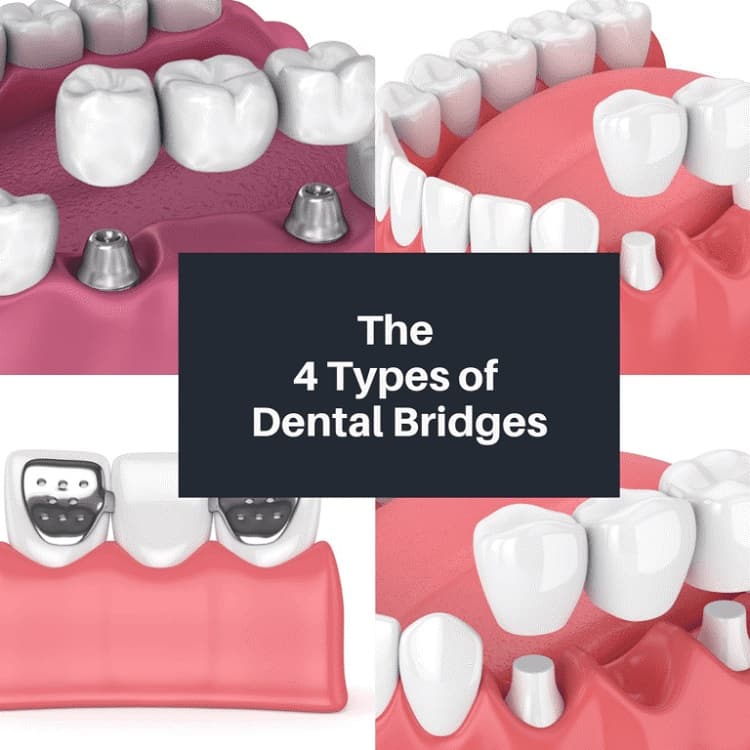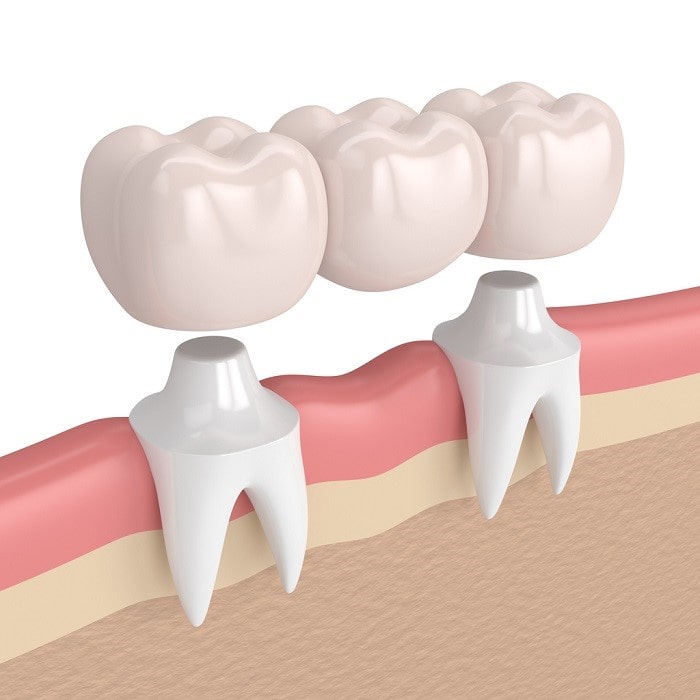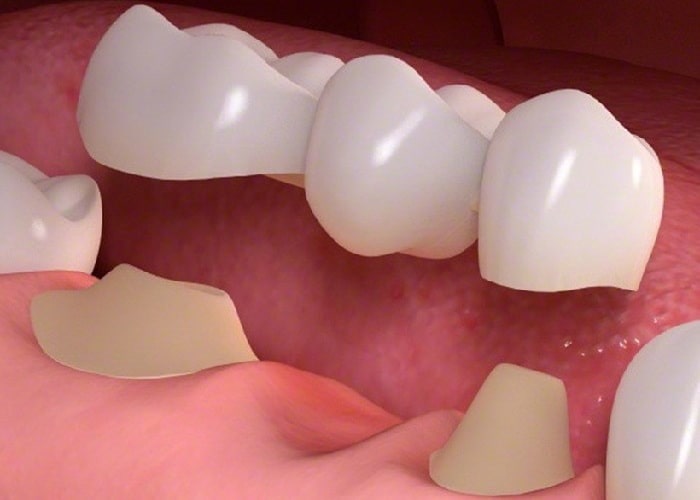A dental bridge is one of the most popular choices to replace a missing tooth. This restorative dentistry procedure can give you back the ability to eat normal foods without pain, and it can protect the teeth around your missing tooth from other problems, as well. To understand more about this procedure and how it might be beneficial for you, read following article.
What Is a Dental Bridge?
A dental bridge is basically a prosthetic tooth that is held in place by two crowns. This sounds complex, but it is actually quite simple. The bridge is a single piece, shaped like three consecutive teeth. The two teeth on the ends, though, are actually crowns that affix to the teeth adjacent to the missing tooth. Thus, they “bridge” the gap in your teeth.
Why Do People Get Dental Bridges?
If you have a single missing tooth between two healthy teeth, then you may be a candidate for a dental bridge. For many years, this was the most effective and natural looking means to replace a missing tooth. However, thanks to advances in dental implant technology, many people are opting for an implant that will not require any other teeth to be filed or prepped for a crown.
How many types of Dental Bridges?
There are four types of dental bridges:
- Traditional Fixed Bridge:A dental bridge is a false tooth, known as a pontic, which is fused between two porcelain crowns to fill in the area left by a missing tooth. This is known as a fixed bridge. This procedure is used to replace one or more missing teeth. Fixed bridges cannot be taken out of your mouth as you might do with removable partial dentures.
- Resin Bonded Bridges:The resin bonded bridge is primarily used for your front teeth. Less expensive, this bridge is best used when the abutment teeth are healthy and don’t have large fillings. The false tooth is fused to bands that are bonded to the abutment teeth with a resin which is hidden from view. This type of bridge reduces the amount of preparation on the adjacent teeth.
- Cantilever Bridges:In areas of your mouth that are under less stress, such as your front teeth, a cantilever bridge may be used. Cantilever bridges are used when there are teeth on only one side of the open space. This procedure involves anchoring the false tooth to one side over one or more natural and adjacent teeth.
- Maryland Bonded Bridge: A Maryland bonded bridge uses the same structure as a traditional dental bridge, however instead of using dental crowns as anchors, a metal or porcelain framework is used. This framework eliminates the need for modification of the adjacent teeth and is simply adhered to the back instead. Essentially, Maryland bonded bridges provide a conservative and more affordable alternative to traditional bridges. However, their strength depends on the strength of the adhesive and metal frameworks can cause tooth discoloration.
Choosing the right material for dental bridge
dentists offers a variety of crown material options for patients including: Gold alloy, Porcelain, Porcelain fused to metal (PFM), Zirconia, and Porcelain fused to Zirconia.
The material dentists recommend for your crown will depend on a number of factors, including which tooth the crown will be used on, whether you grind your teeth and if you are allergic to metal. Before choosing the material for your crown, it’s important to discuss the pros and cons of each option.
- Gold alloy has been used in dentistry for a very long time and is one of the strongest materials available. It’s resistant to wear, making it a great choice for patients who grind their teeth. Gold also does well when placed next to natural teeth and is less reactive and easy on the gum tissues. Gold, however, is most often used on hard to see teeth in the back of the mouth because many do not like to show gold when they smile.
- Porcelain fused to metal is made with a strong metal substructure and the porcelain is bonded to the metal to mimic the look of a natural tooth. This helps retain the strength of the crown, while still matching the color of the surrounding teeth. A PFM crown or bridge is an excellent option for any location in the mouth. Often this is the material of choice because it gives outstanding cosmetics and when placed below the gum line give a very reliable seal around the margin of the restoration.
- Porcelain and Porcelain fused to Zirconia are often chosen as the go-to crown materials for cosmetic reasons, in addition to the fact that there is less sensitivity to hot and cold with these materials. The downside of 100% porcelain crowns, however, is that the material can fracture, especially for patients who grind their teeth. Dentists have overcome this limitation with Zirconia and Porcelain fused to Zirconia. Both are metal free (which is excellent for patients with metal allergies), fracture resistant, and look beautiful.
How are crowns placed on teeth?
Crown placement is typically completed in two visits. First, dentist will remove a thin layer of enamel coating and shape the tooth to provide room for the crown. This process allows the crown to be placed without crowding neighboring teeth or creating an uneven bite. Then dentist will make an impression of the teeth, which is sent to an on-site lab where the crowns will be made from the most advanced materials for long-lasting durability.
The dentist will fit a temporary crown, which is crafted from resin, to protect your tooth while the permanent crown is being made. At the second visit, the temporary crown will be removed and the tooth will be carefully cleaned before the permanent crown is applied using a strong adhesive.
How do I care for my crowns and bridges?
It is important to maintain excellent oral hygiene, making sure to brush and floss twice a day. Avoid biting on hard foods like nuts and candy that can potentially fracture the restoration.
Which foods should avoid with a temporary dental crown?
Because temporary crowns are made from acrylic, which is less strong than the metal, ceramic or porcelain material of a permanent crown, you must take extra precautions. Limit the amount of chewing you do on the side of your mouth where your temporary crown is located. Avoid chewing on hard candies, nuts and very crunchy fresh vegetables such as carrots on the same side of the mouth as your temporary crown. Until your permanent crown is in place, don’t eat sticky desserts or candy, including caramels, licorice, jelly beans, taffy, toffee and gummy bears, as they could pull the temporary crown off your tooth. Avoid chewing gum for the same reason.
Which foods should avoid for permanent dental crowns?
- Hot foods:Some individuals experience a mild-to-severe sensitivity in and around a crowned tooth when eating hot foods, particularly if they are affected by gum recession. If the problem persists, consult your dentist as the crown’s fit may require adjustment.
- Cold foods:Although they do not harm your crown, such foods can trigger sensitivity similar to that caused by hot foods if any part of your gum recedes enough to expose the root above a crowned tooth. Your dentist may suggest that you use a toothpaste made especially for sensitive teeth; such toothpaste work by blocking the sensation traveling from the tooth to the nerves.
- Sugary foods: Avoid constant exposure to sugary drinks, candy or gum, keep snacking to a minimum, and brush or rinse your teeth after eating chewy or sticky foods such as dried fruit.
Faq
is the procedure painful?
The short answer here is, “No.” Before the procedure, the dentist will apply local anesthesia to numb the area. In general, the dentist will test if the patient still feels anything, asking if the area hurts when poked or prodded. If the answer is yes, then the dentist will wait for a few more seconds or minutes to allow the anesthesia to settle.
Will the bridge affect normal function?
Again, the answer here is no. The bridge and crown will serve as the replacement of your missing tooth/teeth, and as such, will function as your normal teeth would. In other words, you don’t have to worry about chewing, eating, spitting, sipping or swallowing with the bridges and crowns in place. If anything, they will return your dental functions back to normal.
How long will the bridge and crown last?
Generally, bridges and crowns last anywhere between 5 and 15 years; more in some patients. The key is proper oral and dental care. Your dentist can give you some tips on how to prolong the life of these dental appliances, and they can also perform routine teeth cleaning, together with your entire set of teeth, every six months.
Are bridges and crowns better than dentures?
Both dental appliances are installed to help return normal functioning, from biting food to chewing and everything else; and such, one isn’t necessarily better than the other. Your dentist will be the one to determine which dental appliance is best for you, usually based on the number of teeth missing, the health of your gums, and the health of the teeth that will serve as the anchor.
Can I take my dental bridge out during the day?
No, a dental bridge is called a “fixed” dental prosthetic. This means that it remains in place all day and all night – we bond the device to your teeth. If you are looking for a removable option, you may wish to consider dentures.
Can I replace up to three teeth in any configuration?
No, a dental bridge can only replace one tooth or up to three missing teeth that previously sat side-by-side.
How can I make my bridge last longer?
Wondering how to extend the life of your bridge? This is simple! Do your best to keep up with consistent preventive care. This means practicing consistent daily dental hygiene, including brushing and flossing. It also means visiting dentists for cleanings and checkups with the frequency they suggest – most patients should see dentist once every six months.
Are there alternatives to dental bridges?
dentists generally recommend implants as the “gold standard” when it comes to replacing teeth that are badly damaged, or filling gaps caused by missing teeth. So, that is one alternative to a dental bridge. The other alternative would be dentures. If you have very few teeth left, and do not want dental implants, then you could consider
can anyone benefit from dental bridges?
Yes, generally speaking. Complications from dental bridges are very rare, and you will find that a dental bridge will feel and work very much like your own teeth. As long as the teeth that will work to support your dental bridge are healthy, you can expect to get many years of service from your dental bridge.
Can dental bridges be repaired?
Even though bridge tooth replacements can last for many years, problems still occur. If you have a broken bridge, or your dentist notices something concerning during a routine dental exam, then he or she may be able to repair the damage. Just be sure to see your dentist as soon as possible if you notice something wrong with your dental bridge. Putting things off could mean the loss of your bridge!
Can you replace a dental bridge?
In short, yes — you can replace a dental bridge. If your bridge has significant chipping, breakage, or comes off completely, then your dentist may want to replace it with a brand new one. However, a replacement bridge typically won’t last as long as the first one. If you want a more permanent option that will last longer, dental implants are typically recommended as a far better tooth replacement option.
Will people be able to tell if I have a dental crown or bridge?
Today’s crowns and bridges are made of natural-looking composite materials that make them virtually indistinguishable from your natural teeth.
Some people having Crowns with black, darkened lines in between their gums and teeth. Are they cause by Crown or Bridges?
The newer all porcelain crowns are an esthetic improvement over older, porcelain fused to metal crowns as if the gumline would recede, the older crowns often showed a metal edge to the crown that originally was hidden from view. Since all porcelain crowns have no metal, no markings are evident if the gum line recedes.
If having a root canal and it is quite discolored, can Porcelain Crown be the best approach?
If a tooth that requires root canal therapy discolors, it is an indication that the nerve inside the tooth had died and blood pigments have broken down and been absorbed into the calcified tooth structure. By placing an all ceramic porcelain crown on the tooth, it can restore the tooth to match its neighbors.






